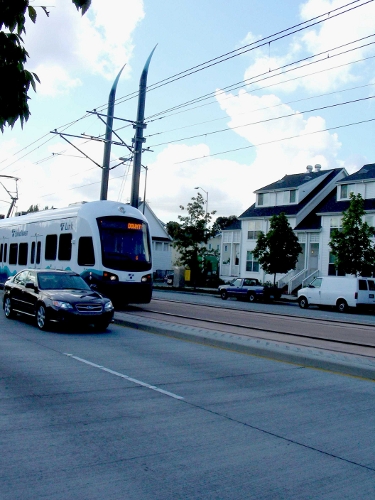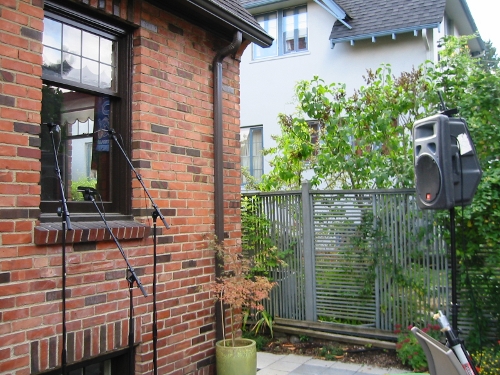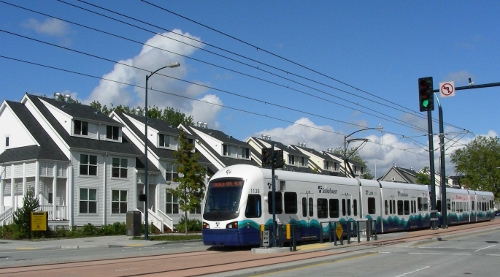"Green" Peace and Quiet
Julie Wiebusch - juliew@greenbusch.com
The Greenbusch Group, Inc.
Seattle, WA
Popular version of paper 5aNS9
Presented Friday morning, October 30, 2009
158th ASA Meeting, San Antonio, TX
Light Rail has arrived in Seattle. The first link, a 14-mile electric railway system, opened in July 2009, making access from South Seattle to the downtown core, easier and more efficient. The ability of a light rail system to run along streets and share space with road traffic makes it an ideal choice for an urban setting. Seattles new light rail operates on embedded tracks at street level, along elevated structures and through tunnels. This study focused on the street level segment and the potential increase in noise levels for residents along the alignment.
In order to accommodate the light rail, an arterial through Seattles Rainier Valley neighborhood was widened to allow the trains to travel down the center of the roadway. Not only did this introduce a new noise source (the light rail train) into the community, it also slightly increased existing traffic noise as the widening of the street relocated traffic nearer to the homes. Figure 1 shows the configuration of rail and traffic and the proximity to residences.

Figure 1. The light rail travels down the center of the road
Studies were conducted to predict the level of increased noise for homes along the alignment. The metric used to define the light rail noise was the Day-Night Level (Ldn). This metric is based upon a 24-hour average of sound with a penalty added to any sounds occurring between the hours of 10:00 PM and 7:00 AM. The penalty is intended to reflect a higher sensitivity to noise during typical sleeping hours. The traffic noise metric was based upon an hourly Equivalent Level (Leq), which is the average sound in a one-hour period. The loudest hour is used to assess impact.
The initial program included 137 residences, with predicted exterior sound levels due to the project, that were high enough to be considered impacted. Sound Transit, the local Transit Authority, received a grant from the Federal Transit Administration (FTA) to launch a Residential Sound Insulation Program (RSIP), designed to reduce transportation noise intrusion into homes. Each home received an acoustical audit to measure the level of sound insulation provided by the existing construction. Figures 2 and 3 demonstrate two approaches to measuring the sound insulation properties of window elements.

Figure 2. Masurement approach #1

Figure 3. Measurement approach #2
Once data was collected on a homes existing insulation characteristics, the evaluation was completed by considering the predicted exterior noise levels, from the light rail and relocated traffic, against the existing insulation characteristics of the residence. Homes with predicted interior noise levels above an established threshold were then eligible to receive a RSIP package.
A unique sound insulation package was developed for each home. A typical mitigation package included sound retardant windows, seals on exterior doors and an upgraded ventilation system to limit the need to open windows. Figure 4 shows the close proximity of homes along the alignment.

Figure 4. Homes receiving RSIP packages benefit from upgraded windows, door seals and ventilation.
RSIP is not a new approach to minimizing residential noise impacts. Programs such as this can be found throughout the nation. However, the Sound Transit RSIP program was exceptional due to a unique approach in two areas. Sound Transit resolved first to improve the equity for the low income and minority communities who felt the burden of the project (inconvenience during construction and increased noise levels during operation) and, second, to reduce the detrimental environmental effects from the project.
A commitment was made to maximize the use of small businesses and Minority, Women and Disadvantaged Business Enterprises (MWDBE) to reflect the ethnicity of the Rainier Valley community. Where possible, neighborhood enterprises were used. The bid packages were kept small, usually no more than 10 homes with a total construction cost under $100,000. This kept bond prices lower for small contractors. A supply warehouse, provided and staffed by Sound Transit, allowed contractors to purchase materials and store them at the warehouse. Sound Transit was able to reimburse the contractor immediately for goods turned over to them to warehouse, reducing their need to finance. Many of the small contractors had no previous experience in light rail construction projects. Sound Transit provided assistance with the administration of the project and guidance, as needed. At the end of this first light rail project, 100% of both Architectural and Engineering consultants (A&E) and contractors utilized were small businesses. MWDBE firms comprised 55% of the A&E design teams and 50% of contractors and their subs. Johnathan Jackson, Sound Transits Link Light Rail Department Program Manager for RSIP, commented, "It was essential to Sound Transit that we mitigate all light rail design impacts, which included residential noise intrusion. When developing our contracting methodology it was decided early on that this contract would utilize Small Business for the A&E work and local small contractors to do the residential sound insulation noise analysis, interior architectural design elements and the actual retro-fit construction. Sound Transits RSIP is sort of like a local neighborhood small business stimulus package."
Though the project didnt pursue measured sustainability goals, such as LEED certification, Sound Transit was resolute in their desire to create a project that reflected good stewardship of the environment. Recycle containers for contractor use were located at the Sound Transit Warehouse. Salvageable materials, for example the windows that were removed from homes, were gifted to organizations such as Habitat for Humanity. 100% of the construction debris was kept out of local landfills. New materials specified in the RSIP mitigation packages conformed to principals established by The Leadership in Energy and Environmental Design (LEED) program of the U.S. Green Building Council. Wood doors and trim were Forest Stewardship Council (FSC) certified. Indoor Air Quality was enhanced with the ventilation improvements. Energy efficiency increased as old single glazed windows were replaced with insulated, acoustical units. Quality of life was enhanced with the quieter interior environment. Sound Transits RSIP program provided far more than acoustical insulation for these homes, they improved the sustainability and livability of this community. This project is a prime example of how both acoustical and sustainability goals can be achieved through conscientious project management.

Figure 5. Please dont drive on the tracks.